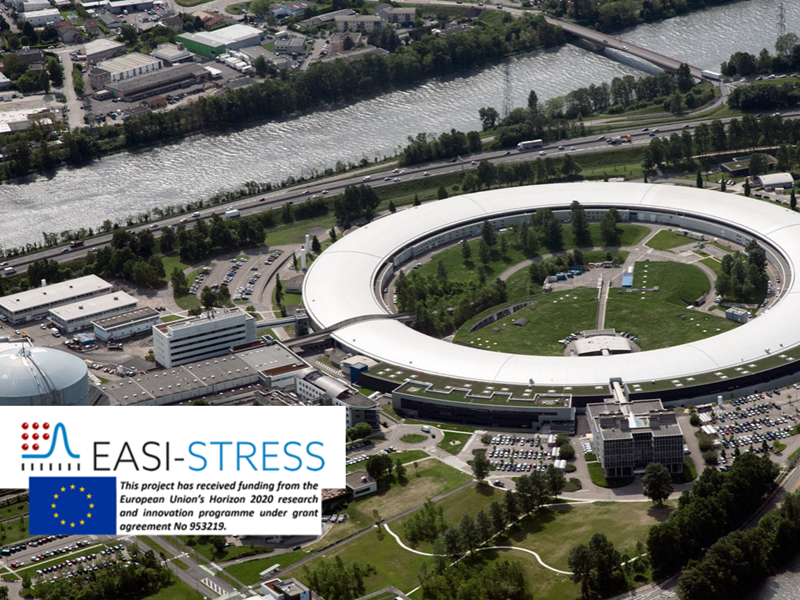Nemak is a leading provider of innovative lightweighting solutions for the global automotive industry, specializing in the development and manufacturing of aluminum components for powertrain and body structure applications.
Standardisation of industrial residual stress characterisation: EASI-STRESS

Since the beginning of 2021, Nemak has been engaged in the EU-project EASI-STRESS with partners from industry, academia and research and technology organisations. The project is now picking up speed: After months of preparation, the scientists now examine the first samples at Institut Laue-Langevin and European Synchrotron Radiation Facility ESRF (both Grenoble), at instruments of Helmholtz-Zentrum Hereon at DESY (Hamburg) and at Budapest Neutron Center BNC (Budapest).
There have always been various ways of working metals. For example, they can be forged, welded, cast or additively manufactured. In all these processes, residual stresses are generated in the material. But: Residual stresses in metals may lead to catastrophic failures under fatigue processes. Therefore, they are of key importance across all industrial sectors where metals are used, e.g. within the transportation and energy sectors. Such residual stresses are investigated using various methods. These include neutrons and synchrotron X-rays. They penetrate into metals and alloys and enable non-destructive direct determination of bulk stresses.
Insufficient comparability
In the past, industrial developers have struggled to utilise synchrotron x-ray and neutron diffraction-based residual stress characterisation tools due to insufficient data comparability and lack of harmonised protocols. This made it difficult to confirm reproducibility and traceability of the measurements. “We aim at lowering these barriers for industry by setting up European-wide standards and operating procedures and harmonising data formats,” explains project coordinator Dr. Nikolaj Zangenberg.
The EASI-STRESS project wants to support companies in analysing and improving their materials in the best possible way. With the help of the measurements, the industry can better predict and control stresses in materials and thus optimize the design of components. It is also sustainable: those who know their materials well can reduce material consumption or shorten time to market by qualifying new materials or processes more quickly.
During November, the project partners will conduct experiments from performed residual stress measurements on new developed round robin samples. The samples are measured at several neutron and synchrotron instruments, relevant standardised laboratory techniques. The results will be compared to modelling data. The samples are designed to replicate different industrial processed that will, at a later stage in the project, also be investigated in real industrial components through case studies defined by the industrial partners.
Nemak’s role in the project
Nemak has been engaged by contributing its wide casting expertise and by providing aluminium-cast round robin samples and cylinder heads, whose manufacturing induced residual stresses will be measured using destructive and non-destructive characterisation tools. The experiments will help Nemak to validate its innovative residual stress simulation approach and hence to strengthen its capabilities to develop automotive components and production processes optimized for residual stresses. The measurements will also serve to display the applicability of the developed standards, protocols and data exchange procedures by considering the general needs of the aluminium casting industry.
The goals of EASI-STRESS are:
• improving synchrotron x-ray and neutron diffraction-based residual stress characterisation tools for the needs of industrial use
• developing European-wide characterisation standards, protocols and data exchange procedures to facilitate the industrial use of the characterisation tools, e.g. through traceability and comparability
• strengthening European industrial uptake of the characterisation tools through open access to data and protocols, development of a test bed service and collaboration/synergy/standardization activities
• to secure a competitive advantage across European industrial sectors through optimised component design, reduced material use through reduced safety factors (material savings of around 15%) and an estimated cost-reduction of 5% in a EUR 350 billion market through shortened time-to-market, and increased lifetime
The EASI-STRESS consortium consists of the following partners:
Research Infrastructures: Institut Laue-Langevin (FR, GER, UK), European Synchrotron Radiation Facility (FR), Helmholtz-Zentrum Hereon (GER), Centre for Energy Research (HU)
Universities and Research and Technology Organisations: Danish Technological Institute (DK), University of Manchester (UK), CETIM (FR),
Industry: Siemens Gamesa (DK), Rolls Royce PLC (UK), OHB Systems AG (GER), Volume-e (FR), Arcelor Mittal (ESP), Nemak (AT), EDF (FR),
Standardisation body: Dansk Standard (DK)
More information at: www.easi-stress.eu
Follow us on
Twitter: @EASI_STRESS
LinkedIn: https://www.linkedin.com/showcase/75054908
Contact:
Project coordinator
Dr. Nikolaj Zangenberg
Director Materials
Danish Technological Institute
nzg@teknologisk.dk
Communication officer
Dr. Marc Thiry
Helmholtz-Zentrum Hereon